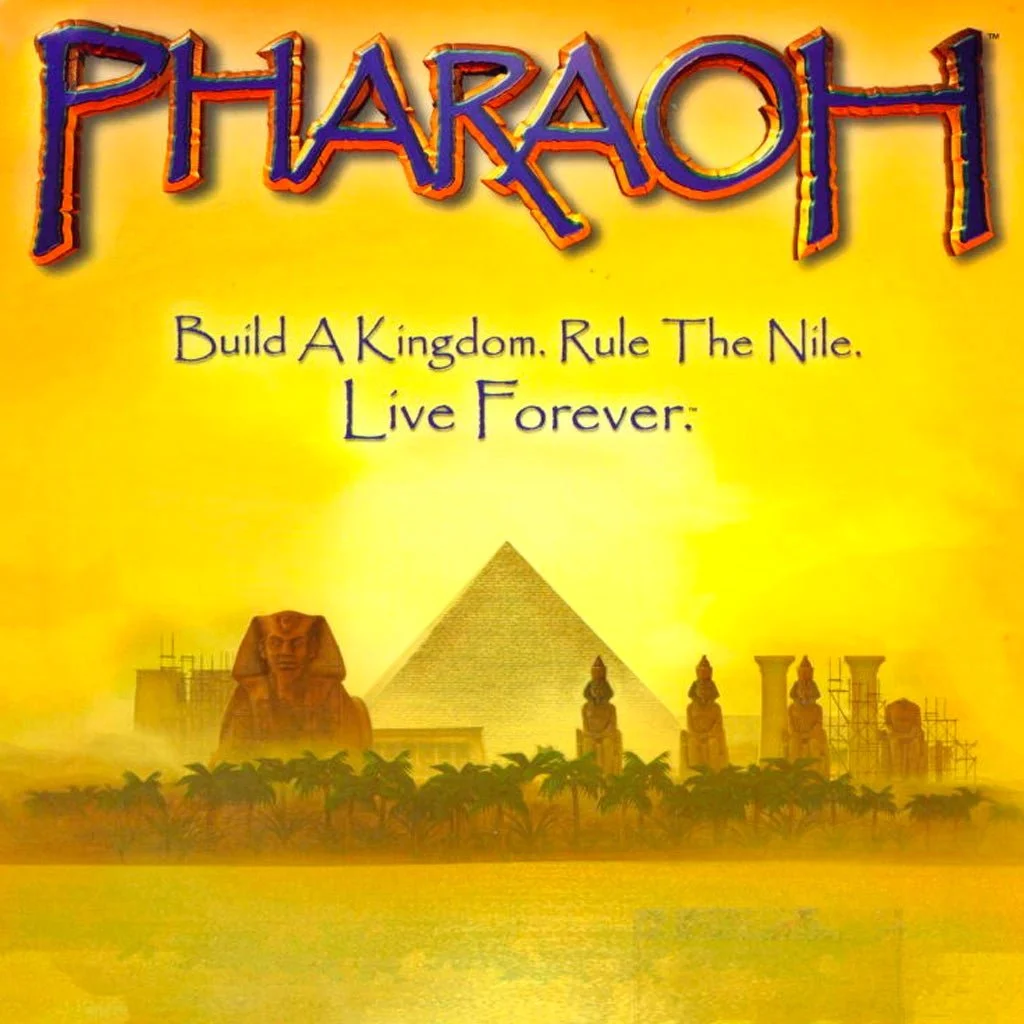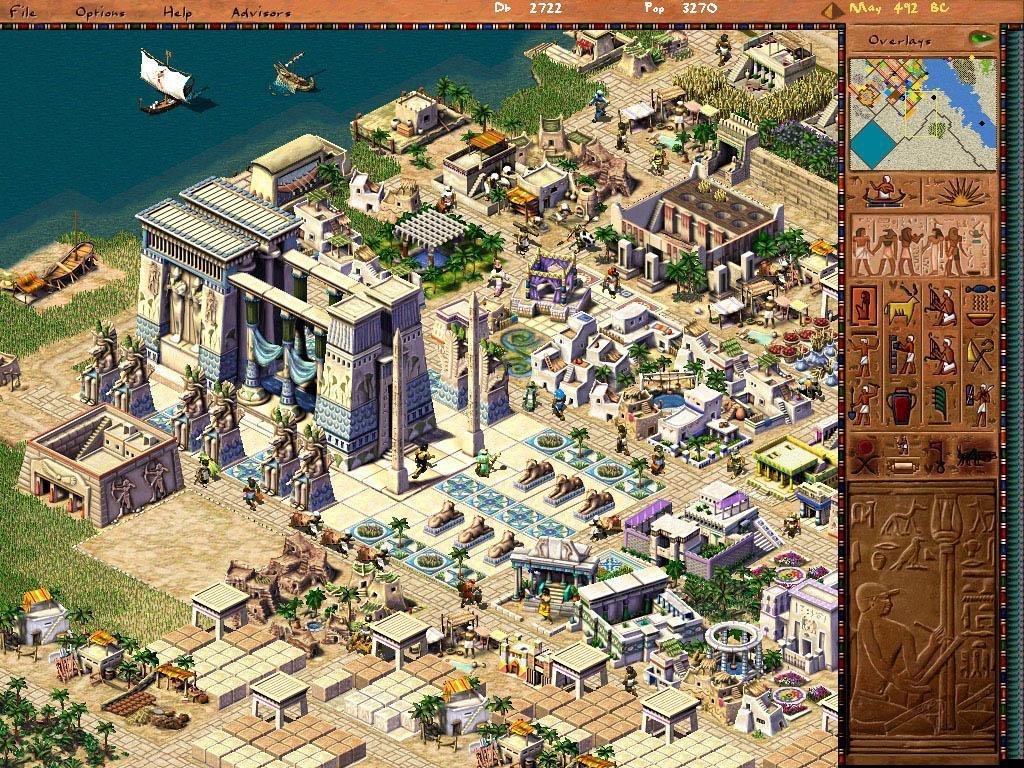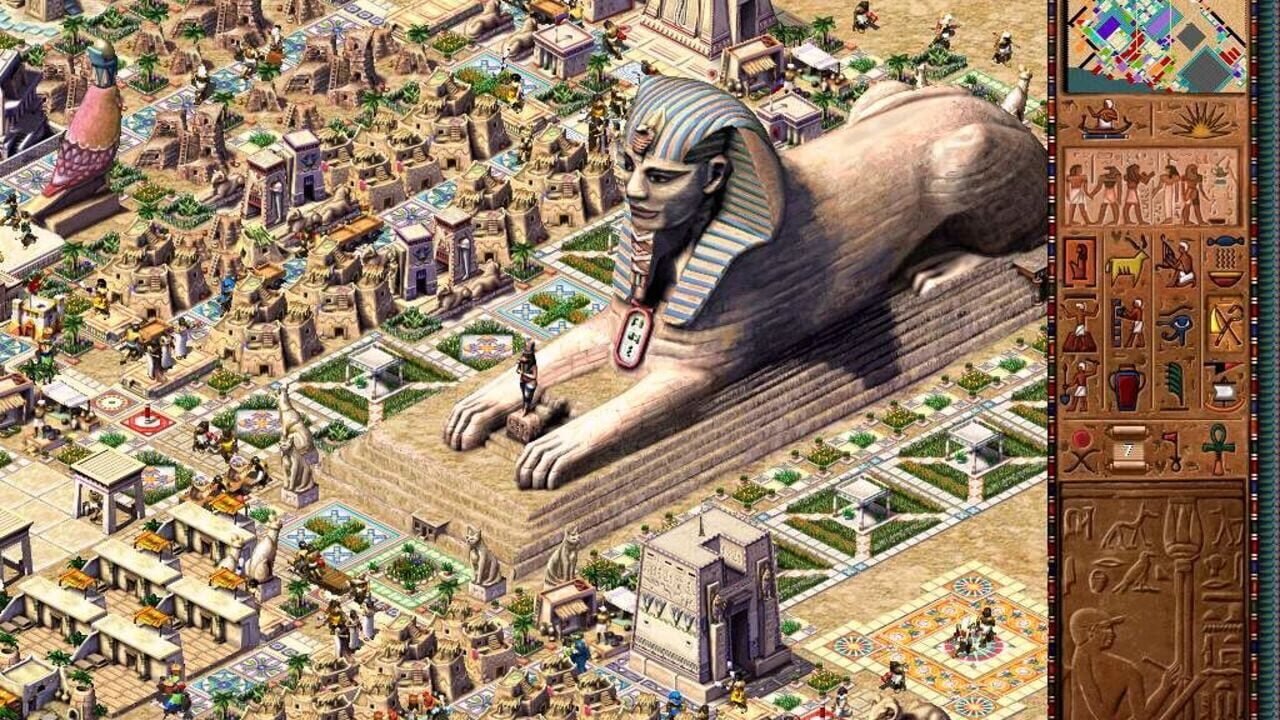Pharaoh: Vinny’s on the Wrong Side of the Toolbar
Let’s talk about videogame software interface design: specifically toolbars. Specifically in the PC Game Pharaoh.
Here’s what I like about it: the toolbar in the game takes up about a fifth of the screen and it’s gorgeous to look at. Unlike many of the toolbars I’ve encountered, either in videogames or productivity software, Pharaoh’s is gorgeously decorated so that it resembles a clay tablet, and in the base is a large relief sculpture of what appears to be a scribe writing on a tablet beneath a lamp or tree, and around them are hieroglyphics. It’s such a little thing, but the act of staring at this toolbar, and the icons contained within which allow the construction of houses, municipal buildings, beautification projects, or general manufacturing facilities feel just as much a part of the artwork of the game as its actual components.
Nostalgia is distracting me though.
I need to provide some context before I continue.
Though I’m still steadily learning more and more about the history of videogames, videogame design, videogame production companies, and the economics of the videogame market, I have to throw out the old pithy platitude that “I’ve still got a lot to learn.” There’s a joy in knowing that even after spending around 30 years years playing videogames I am, as of this writing, still a bit of a neophyte when it comes to knowing about how videogames operate. For example, the collection of words, “isometric city builder,” would have meant nothing to me over a year ago despite the fact that I spent a significant portion of the year 1999 playing one.
My parents, to their credit, never embraced the attitude of “you need to go outside and play and turn off that damn idiot-box” mentality. Part of the reason was because I was allergic to mold, dust, and tree pollen which left me a puddle of snot and agony if I stayed outside for too long. I was a pretty creative kid who usually spent a lot of time drawing and reading comics, so naturally when my Dad started buying computers for record-keeping, educational personal-computer(PC) games began showing up.
Being a kid in the 90s The Mummy movies were coming out (hence the title), and I became OBSESSED with ancient Egypt (Rachel Weisz may have also had something to do with it). I literally had a three ring binder full of informative worksheets, copies of articles from National Geographic, pages full of illustrations of the various deities, and even thin books I would tuck into the folder and carry around just in case I needed to open it up and remember how brains were removed during the mummification process. Naturally when I spotted a computer game with the title Pharaoh it didn’t take too long to talk my parents into adding it to the shopping cart.
Pharaoh was published by Sierra Entertainment (originally started as On-Line Systems by Ken and Roberta Williams) in 1999. Sierra would produce numerous titles including the Caesar series, Leisure Suit Larry, Mystery House, and Quest for Glory to name a few. As of this writing, the company no longer exists; it was eventually bought by Activision who has re-released several of the company’s games (though this is Activision we’re talking about, so I suspect some necromancy was employed for seedy profit concerns), and in fact in February of 2023 Pharoah: A New Era was released on Steam.
I may or may not be slowly building a gaming PC just to play it.
Pharaoh was an educational game because it was, on the surface anyway, trying to educate players about the culture and history of Egypt.
Pharaoh was also my introduction to city-building simulators.
If my reader doesn’t know, a city-builder simulator is as its title suggests: a videogame simulator where you build a city. The simulator genre is packed full of examples including Lawn Mower simulator, PC Builder Simulator, Power Washer simulator, Farming Simulators, and Goat Simulator (though that last one has some slight tonal differences from the previous examples(just a few)). These sorts of simulators vary in their complexity depending on the year they were released as well as what production company released them. I suspect however the model most casual readers and gamers would know would be the classic SimCity franchise.
Personally, I never played any of the SimCity games, mostly because I didn’t vibe with the aesthetic. That and I couldn’t figure out how plumbing infrastructure worked. To any and all civic engineers reading this essay, I don’t know how you do it but I’m positive y’all are sacrificing goats to some eldritch Lovecraftian monstrosity for your knowledge. Whatever you’re feeding that ancient one she’s not paying you enough.
And yes Eldritch monsters can be “shes.” (#eldergods #feminism).
Pharaoh was a different story. I LIVED in Pharaoh. And given its current ratings on Steam I clearly wasn’t the only one.
The game is broken up into a series of levels where the player is presented with a set amount of initial investment capital in the form of debens and then some basic or complex goals for building and developing a city. Each of these missions comes with its own challenges, usually in the form of limited food supply or water, but sometimes there will also be a goal attached to build a monument of some kind, and because this is ancient Egypt many of them are mausoleums and/or pyramids.
I have to be honest and confess I never got far enough in the game to actually build a pyramid to completion. I could lie and say it was because the game was buggy, and in some cases it was, but let’s be real it’s because I didn’t manage my city well.
It’s also because I learned the “Hippo Stomp” cheat code.
Let’s see people complain about my tax rate when Hippos are literally eating the town.
At some point I should actually return to the focus of this essay which was supposed to be about toolbars.
Admittedly Pharaoh’s toolbar is not a monumental development in terms of videogame history, and nostalgia is definitely playing some role here, but please, hear me out. Most people living in their day-to-day lives in this current age will have some experience interacting with and navigating a computer. Whether it’s the small, rectangular one in their pockets, their $8000 gaming PC, or even the ATM on the block where they cash out their pay-check, human beings are becoming increasingly knowledgeable, by necessity, of interacting with computer software. And most of this software incorporates some aspect of a “toolbar” mechanic.
In Pharaoh, like many city-building-simulators, there’s a toolbar which acts as the main center of player interaction, meaning it’s the site where most of their operations will take place. Pharaoh is a point-and-click interface program, meaning that the player will use a computer mouse to place most of the structures in the game: houses, granaries for food storage, juggling schools, religious buildings like shrines and temples, papyrus manufacturing depots, farms, libraries, etc. On the right hand side of the screen, taking up about a fifth of the total monitor space is the toolbar, and contained within it are twelve icons. These icons are, typical to most city-building simulators, symbols to designate what structures the player can access and create by clicking on them.
And, because Pharaoh is a beautifully designed game, these icons are hieroglyphics.
At the start of each mission there is a window containing an in-game tutorial to help the player learn how to use this toolbar (complete with images of how these structures work in-game), and from there the player is left to, well, play with the system.
Pharaoh’s toolbar is still memorable, close to two decades later, because it was so easy to master and navigate. It didn’t matter that I didn’t have words marking which options would build agricultural structures and which would build military structures. I learned through the process of regular and consistent use that the blue-red pot would be where I could make granaries and bazaars, while the Eye of Horus meant anything related to religion. It could be that there was a basic memorization since the 4x4 grid was not too difficult to work with, but I still believe that in terms of software interface design, it was just a great system.
It was also a wonderful tool for eventually having to navigate programs like Microsoft Office and Google Docs.
Working at a public library like I do, I have become used to the sentiment expressed by patrons and well-meaning family members, “It must be nice being able to read everyday.” Any experienced library employee knows what I mean when I say the only sane response is to nod and say “Yeah I read a lot,” because I do. I read emails. I read reference websites to locate forms and documents for patrons. I navigate the screens of the copy machines and document scanners. I read press releases for the city, as well as updated policies and announcements concerning the regional municipality I’m employed by. I read book summaries for patrons who ask that daunting question, “Can you recommend a book to read?” My professional existence is largely based around reading, and most(if not all) of that reading is done in software.
Pharaoh as a city builder is still an impressive videogame for the way it allowed me to gain an introduction to how society operates at a management level. It gave me the chance to see in 1999 how a municipality works, and now in 2023 I work for a municipality.
Thanks Mom & Dad, I told you buying computer games would pay off.
Literally every component of the city building process was achieved by navigating a tool-bar, and while government is far, far more complex than that in real life, the long-term impact of games like Pharaoh can still be felt in my life. I’m writing this essay in GoogleDocs before publishing it on my website on Squarespace and both programs have unique toolbars which provide me with options for creating and adjusting the words on this page the way I might move a city architect’s office or relocate a shipping yard.
Pharaoh’s toolbar is simply a great piece of software interface design because it is not difficult to navigate; in fact it’s simple.
As a medium videogames are often perceived solely as means of entertainment. And let’s be real, videogames ARE entertaining, that’s why we play them. However, videogames have been continually part of the personal computer movement, and their development has created tools that impact professional working spaces, as well as the educational system. It’s logical the to observe how videogames can, and have, inspired software design that impacts our day-to-day reality. The 4x4 toolbar I used to make an endless number of digital cities along the banks of a digital simulation of the Nile would help me approach and eventually become familiar with the horizontal toolbar(s) that I would have to work with in my professional and personal reality.
I may have never gotten the chance to build a digital pyramid, but hindsight has shown me that I at least would have had the tools to.
Joshua “Jammer” Smith
3.4.2024
Like what you’re reading? Buy me a coffee & support my Patreon. Please and thank you.





